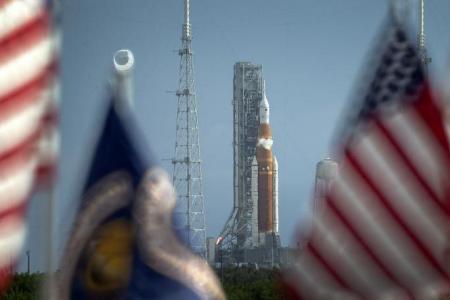Fuel leak delays first launch of Nasa’s Artemis moon rocket for weeks
CAPE CANAVERAL, Florida - For the second time in a week, Nasa on Saturday (Sept 3) aborted an attempt to launch its giant, next-generation rocketship, citing a stubborn fuel leak that the US space agency said could delay the debut mission of its moon-to-Mars Artemis programme by at least several weeks.
Preflight operations were called off for the day about three hours before the 2.17pm liftoff time (2.17am on Sunday, Singapore time) targeted for the 32-storey-tall Space Launch System (SLS) rocket and its Orion capsule from Cape Canaveral, Florida.
The uncrewed test flight, aimed at launching the capsule out to the moon and back, was to have marked the inaugural voyage of both the SLS and Orion a half century after the last lunar mission of Apollo, forerunner of the Artemis programme.
The countdown was scrubbed after Kennedy Space Centre technicians made three failed attempts to fix a “large” leak of supercooled liquid hydrogen propellant being pumped into the rocket’s core-stage fuel tanks, agency officials said.
The initial launch try on Monday was likewise foiled by technical problems, including a different leaky fuel line, a faulty temperature sensor and cracks found in insulation foam.
Mission managers proceeded with a second launch attempt on Saturday once the earlier issues had been resolved to their satisfaction. And Nasa had reserved another backup launch time, for either Monday or Tuesday, in case a third try was needed.
But after a review of data from the latest difficulties, Nasa concluded the new hydrogen leak was too tricky and time-consuming to finish troubleshooting and fix on the launch pad before the current launch period allotted to the mission expires on Tuesday.
The delay means the earliest opportunity to try again would come during the next launch period that runs Sept. 19-30, or during a subsequent October window, an associate Nasa administrator, Jim Free, told reporters at a late-afternoon briefing.
He said the postponement also would involve rolling the spacecraft back into its assembly building, under Cape Canaveral “range” rules limiting how long a rocket may remain at its launch tower before undergoing a new round of safety checks indoors.
Nasa chief Bill Nelson said earlier in the day that a rollback would postpone the next launch attempt at least until mid-October, in part to avoid a scheduling conflict with the next International Space Station crew due for launch early that month.
Launch-day delays and malfunctions are not uncommon in the space business, especially for new rockets such as Nasa’s SLS, a complex vehicle with a set of pre-liftoff procedures that have yet to be fully tested and rehearsed by engineers without a hitch.
On average, the odds of scrubbing a launch on any given day for any reason, including foul weather, are about one-in-three.
“We’re not going to launch until it’s right, and that is standard operating procedure, and will continue to be,” Nelson said at the briefing.
The last-minute setbacks on the launchpad came at the tail end of a development programme more than a decade in the making, with years of delays and billions of dollars in cost overruns under Nasa’s respective SLS and Orion contracts with Boeing and Lockheed Martin.
Get The New Paper on your phone with the free TNP app. Download from the Apple App Store or Google Play Store now

